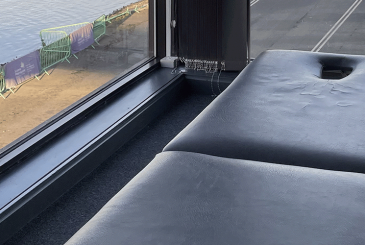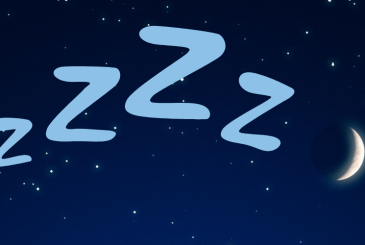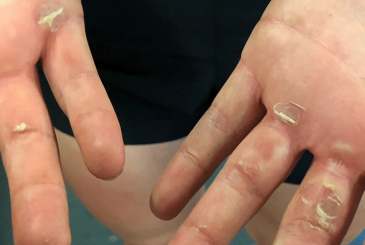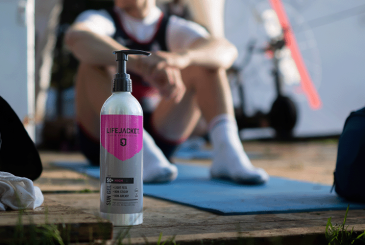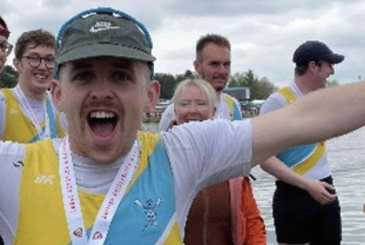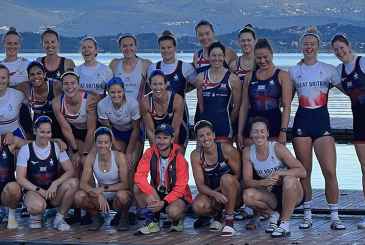In his second article Nick Littlehales listed the seven Key Sleep Recovery Indicators (KSRI’s) that form the building blocks of a new approach to sleep and recovery. In the final article in this series he provides you with the tools to create your own sleep wake cycle and shows you how to redefine your approach
The R90 Technique in principle means recovery every 90 minutes, the length of time it takes us under clinical conditions to go through the key sleep stages. Underpinned by seven KSRI’s Key Sleep Recovery Indicators, a journey designed to help you identify those key factors in your every day that will aggregate up, developing more consistent, sustainable levels of recovery.
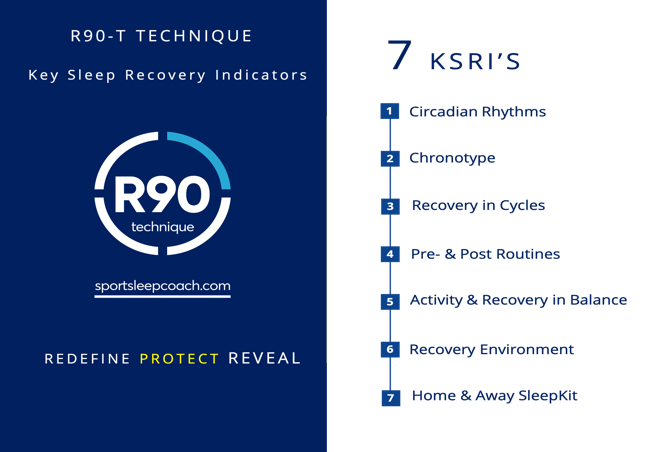
If you think of sleep in cycles per week, not hours per night you can develop a more positive mindset. One or two disturbed nights [periods] out of seven doesn’t then seem to be as negative. We can take the pressure off because it isn’t an all-or-nothing eight hours per night.
Most importantly, we’re aware of how much sleep we’re getting. It is empowering for anyone to take control of their sleep like this, and it is possible to start manipulating cycles in the short term to free up more time for a specific event or period in our lives as part of a controlled regime change.
It’s not about how you slept last night, it’s how you kick start the next 24 hours
Create your own R90 Technique sleep wake cycle program
Identify with your most consistent natural wake time if in full control and use that to break your 24 hour clock up into 16 x 90 minute periods/timings throughout the four phases of every 24 hour period.
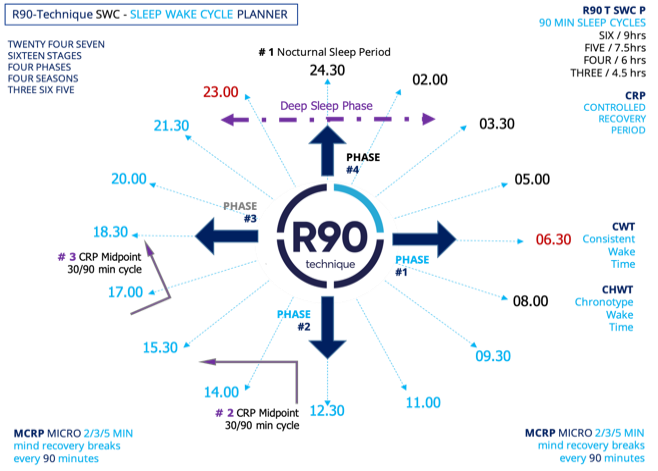
Create your own graphic or go old school with pencil and paper
Now you can use your planner to apply training, sessions, events, occupational and social schedules, a proven technique helping you establish when you can apply your sleep cycles, CRPs, and mind breaks and as importantly, adapt with confidence as things out of your control reveal themselves.
It’s not about how you slept last night, it’s how you kick start the next 24 hours. Focus on your first 90 minutes post sleep after wake, the key period to set your brain, bodily functions, and you up to tackle the rolling 24 hours ahead – maximise the positives and optimise the negatives.
Your goal should be to adopt as much of an unrushed approach as you can, moving from dark to daylight, hydrate, fuel up, bowel, bladder, completing mental challenges, and exercise. Daylight triggers serotonin, the hormone that unsuppresses your bodily functions to reach a fully human active wake state.
CRP’s – Controlled Recovery Periods
Nappers, Snoozers for losers are phrases most definitely for a past uneducated generation. Recovery in cycles, rather than Monoblock hours (all in one block), taking short distractive breaks every 90 minutes, factoring in a 15-30 minute CRP (Controlled Recovery Period) midday, late afternoon or early evening allowing yourself some vacant mindspace creates a mindset of not having to worry about, try and or force yourself to sleep.
No time for a break? Then make time because they are key to revealing your personal best more often, if not every day
Remember your ability to sleep and reveal more consistent, sustainable levels of recovery is all about the rolling 24 seven circadian rhythms of our day, in particular exposure to light at the right times in the four phases of every day.
Lighten Up: In principle humans living outside would be active in 80,000/100,000 Lux [Lumens Daylight] with an average exposure of 10,000 Lux during the first two phases of the day, season and activity dependent, or in principle an average of 1000 lux in every 90 minutes sunrise into sunset.
When daylight enters our eyes in the morning, the first phase of our human day, the brain starts to produce the hormone serotonin, which activates all the things that were suppressed for sleep – mood, motivation, appetite, bowel and bladder.
As the afternoon and third phase draws in and light levels diminish, the brain produces melatonin, which begins to suppress these things, slowly shutting us down in preparation to enter a sleep state. Melatonin will also be produced if not enough natural (Blue) light enters the eye for several hours, inducing feelings of daytime drowsiness, lack of energy and motivation.
Daylight Saving Time – October to March: When we shift the clocks and move from summer into the winter – spring period, daylight hours can shift from 16 hours per day to down to eight hours [planet location dependent].
In this winter period, for many even in elite sport the light exposure is too low throughout the first two phases of the 24 hour cycle. To remain alert and energised therefore, it’s important to find opportunities to get outside first thing in the morning and at intervals throughout the four phases of the day, combined with daylight therapy tools. Over exposure is also common particularly moving into the evening phase (phase three).
Outside Inside Mindset: A key factor when developing and applying your own R90 Planner is adopting the mindset of it’s all about Cycles, Rhythms, Patterns, Phases, and a rolling 24 hour process, a technique designed to help you develop a more proactive mental and physical recovery attitude and your relationship with your inside and outside world.
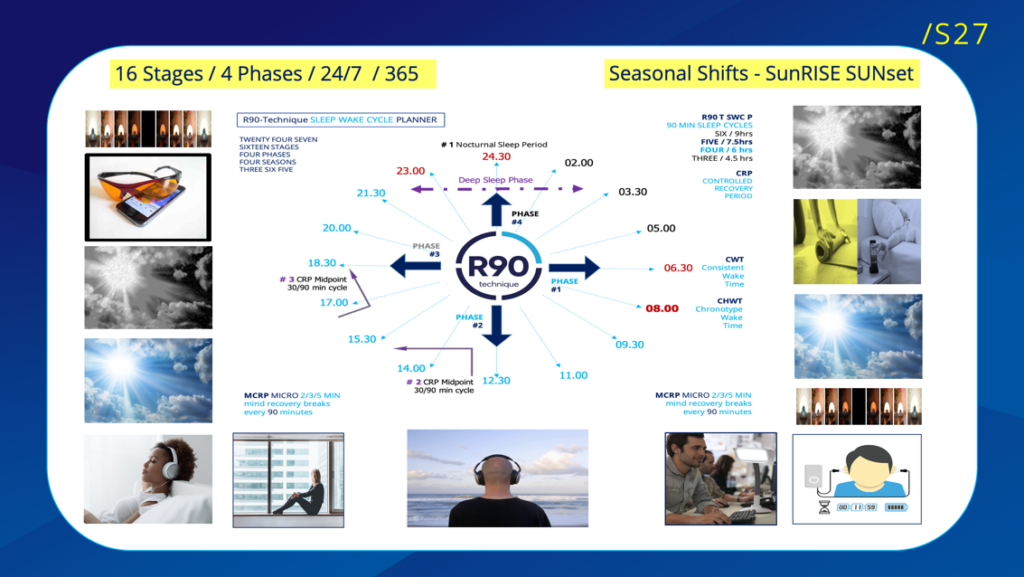
Coach Tip: When you enter a sleep state your brain is in control not you, so what you do from the point of wake determines what level of sleep quality will be realised, irrespective of how long you allocate, eight, nine, ten hours or just one 90 minute cycle.
–
–
–
–
–
–




